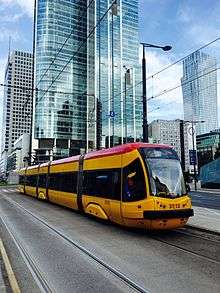Mirów, Warsaw
Mirów is one of the neighbourhoods of the Wola district of Warsaw, Poland. It is limited by the Solidarności, Jana Pawła II, Aleje Jerozolimskie and Towarowa streets.


The area was named after William Mier, a Scottish officer in Polish service and the commanding officer of the Horse Guard of the Polish Crown Regiment stationed in what became known as the Mirów Barracks.
It was a poor suburb until after the World War I. During the interbellum it was gradually built-up with large houses. During the Warsaw Ghetto Uprising and the Warsaw Uprising most of the area was razed to the ground by the Germans. After the war it was not rebuilt, and instead a large residential area with Soc-Realist buildings was created there.
At the easternmost tip of Mirów, at Plac Żelaznej Bramy there are two Mirów Marketplace Halls which survived, and at the western tip of the area, it used to be delimited by two toll collection buildings (which have not been preserved).